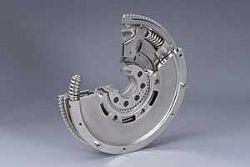Take for example the revolutionary invention of the Dual Mass Flywheel (DMF). It’s true that flywheels have helped to eliminate cyclic irregularities of the engine for a long time. However engine vibrations at low torque or idle speed often experienced as shaking and rattling, were still causing concern and frustration to drivers. There was only one solution to this problem: increasing the transmission’s moment of mass inertia without increasing the weight – a paradox. But this is exactly what DMF does. Function of the LuK DMF With the DMF the angular momentum is decreased in front of the torsion damper and increased behind it. The angular momentum of the engine is now assigned to the primary mass of the DMF, while that of the transmission is assigned to the secondary mass including the clutch driven plate and the clutch pressure plate. In this way, the resonance speed is shifted from approx. 1300 rpm to about 300 rpm and can no longer interfere with driving comfort., An added positive effect is provided by the reduced angular momentum on the engine side: Gear changing is improved thanks to the lower mass to be synchronised, and the synchromesh units are subject to less wear. With previous conventional flywheels and torsion-damped clutch plates, the torsional vibrations in the idle speed range were transmitted to the transmission with the least possible filtering, causing the teeth of the transmission gears to strike against one another (transmission rattle). The use of a dual mass flywheel however, filters out the torsional vibrations of the engine by the complex construction of the torsion damper, preventing vibration from affecting the transmission components – rattling does not occur, and driver comfort is fully ensured. Service innovation by LuK: the DMF on-car tool At the Automechanika 2008 in Frankfurt/Germany, Schaeffler Group Automotive Aftermarket presented a special tool allowing car mechanics to check the function of the DMF while the part is mounted. To date no such tool has been available on the repair market to perform this type of inspection. Using this special tool, workshops can now assess the operating reliability of the DMF and determine whether or not the DMF has to be replaced along with the clutch. Because a worn or defective DMF will inevitably damage the new clutch. Whenever the clutch is replaced, the DMF has to be checked as well. A full test procedure would involve the measurement of the arc spring characteristic which requires a test stand and special tooling not available in a workshop. So far, the only option available to the mechanic is a visual inspection of the part. Grease leakage, scores, discoloration etc. are initial symptoms of severe damage to one or more DMF components. Schaeffler Group Automotive Aftermarket has compiled and published comprehensive information on the design and operating principle of the DMF, damage patterns and remedial measures in the form of a video and an illustrated detailed 27-page technical brochure.
Dual Mass Flywheels invented by LuK
Dual Mass Flywheels invented by LuK
Motorsport
Thursday, 06 November 2008






